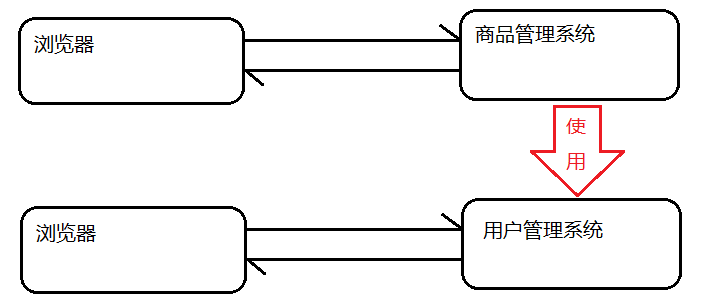Remote call
1. overview
- One project wants to call the functionality of another

-
"User management system" calls "commodity management system",
We call it "remote call". At this time, "user management system" is equivalent to simulating "browser".
2. Call mode
- RPC: the remote call mode of custom data format, which is more inclined to the bottom layer
- Common framework: dubbo
- http: it adopts http remote call protocol and specifies the way of data transmission. The disadvantage is that the message package is too bulky
- Now the popular Rest style can be realized through http protocol
- Common framework: HttpClient,RestTemplate
| Difference | HTTP | RPC |
|---|---|---|
| speed | slower | fast |
| difficulty | simple | complex |
| flexibility | Flexible, cross platform, cross language |
Getting started with 3HttpClient
- Identify maven environment
<!--Determine spring boot Version--> <parent> <groupId>org.springframework.boot</groupId> <artifactId>spring-boot-starter-parent</artifactId> <version>2.1.4.RELEASE</version> </parent> <dependencies> <!--web Start dependence--> <dependency> <groupId>org.springframework.boot</groupId> <artifactId>spring-boot-starter-web</artifactId> </dependency> <!--httpclient--> <dependency> <groupId>org.apache.httpcomponents</groupId> <artifactId>httpclient</artifactId> <version>4.5.6</version> </dependency> <!--Support lombok--> <dependency> <groupId>lombok</groupId> <artifactId>lombok</artifactId> <version>1.0</version> </dependency> <!--fastjson--> <dependency> <groupId>com.alibaba</groupId> <artifactId>fastjson</artifactId> <version>1.2.49</version> </dependency> <dependency> <groupId>org.springframework.boot</groupId> <artifactId>spring-boot-starter-test</artifactId> </dependency> </dependencies>
- Use HttpClient to send Get request
CloseableHttpClient httpClient = null; CloseableHttpResponse response = null; try { //1 create Httpclient object (default connection), which is equivalent to opening browser CloseableHttpClient httpClient = HttpClients.createDefault(); //2 determine the request mode and request path, which is equivalent to entering the address in the browser HttpGet httpGet = new HttpGet("http://localhost:9090/user"); //3. Execute the request and get the response, which is equivalent to pressing enter after tapping the address. CloseableHttpResponse response = httpClient.execute(httpGet); //4 judge status code if(response.getStatusLine().getStatusCode() == 200){ //5.1 types of response data obtained System.out.println(response.getEntity().getContentType()); //5.2 get the response body content and use the entityutilities tool to process it String str = EntityUtils.toString(response.getEntity(),"UTF-8"); System.out.println(str); } } catch (IOException e) { e.printStackTrace(); }finally { //6 release resources response.close(); httpClient.close(); }
-
Use HttpClient to send Post request
CloseableHttpClient httpClient = null; CloseableHttpResponse response = null; try { httpClient = HttpClients.createDefault(); HttpPost httpPost = new HttpPost("http://localhost:9090/user"); // Set request header httpPost.setHeader("content-type","application/json;charset=utf-8"); // Set and process request body String str = "{\"username\":\"jack\",\"password\":\"1111\"}"; httpPost.setEntity(new StringEntity(str,"utf-8")); response = httpClient.execute(httpPost); if (response.getStatusLine().getStatusCode() == 200){ System.out.println(EntityUtils.toString(response.getEntity())); } } catch (IOException e) { e.printStackTrace(); }finally { response.close(); httpClient.close(); } -
Use HttpClient to send Put request
CloseableHttpClient httpClient = null; CloseableHttpResponse response = null; try { httpClient = HttpClients.createDefault(); HttpPut httpPut = new HttpPut("http://localhost:9090/user"); httpPut.setHeader("content-type","application/json;charset=utf-8"); String jsonStr = JSON.toJSONString(new User(1, "jack", "1111", 18)); httpPut.setEntity(new StringEntity(jsonStr,"utf-8")); response = httpClient.execute(httpPut); if (response.getStatusLine().getStatusCode() == 200){ System.out.println(EntityUtils.toString(response.getEntity())); } } catch (IOException e) { e.printStackTrace(); } finally { response.close(); httpClient.close(); } -
Use HttpClient to send Delete request
CloseableHttpClient httpClient = null; CloseableHttpResponse response = null; try { //1. Create a client httpClient = HttpClients.createDefault(); //2. Create a DELETE instance HttpDelete httpDelete = new HttpDelete("http://localhost:9090/user/1"); //3. Send request response = httpClient.execute(httpDelete); //4. Judge the status code if (response.getStatusLine().getStatusCode() == 200){ //5. Utility processing response data System.out.println(EntityUtils.toString(response.getEntity())); } } catch (IOException e) { e.printStackTrace(); } finally { //6. Release resources response.close(); httpClient.close(); }
4.RestTemplate
-
RestTemplate is the client provided by Spring to access the Rest service,
RestTemplate provides a variety of convenient ways to access remote Http services, which can greatly improve the writing efficiency of clients
-
Get request
[@Test](https://my.oschina.net/azibug) public void testGet(){ RestTemplate restTemplate = new RestTemplate(); // Set url, return value type ResponseEntity<BaseResult> entity = restTemplate.getForEntity("http://localhost:9090/user", BaseResult.class); // Return status code System.out.println(entity.getStatusCode()); // Return response body System.out.println(entity.getBody().getData()); } -
Post request
[@Test](https://my.oschina.net/azibug) public void testLogin(){ RestTemplate restTemplate = new RestTemplate(); // Set url, request body (automatic processing), return value type ResponseEntity<User> entity = restTemplate.postForEntity("http://localhost:9090/user/login", new User(1,"jack","1234",18), User.class); System.out.println(entity.getStatusCodeValue()); System.out.println(entity.getBody()); } -
Put request
[@Test](https://my.oschina.net/azibug) public void testPut(){ RestTemplate restTemplate = new RestTemplate(); // Set url restTemplate.put("http://localhost:9090/user",new User(1,"jack","1234",18)); System.out.println("Modified success"); } -
Delete request
[@Test](https://my.oschina.net/azibug) public void testDelete(){ RestTemplate restTemplate = new RestTemplate(); // Set url restTemplate.delete("http://localhost:9090/user/1"); System.out.println(" Delete successful"); }
5.SpringBoot integrates HttpClient and RestTemplate custom connection pool
package com.czxy.config; import org.apache.http.client.HttpClient; import org.apache.http.client.config.RequestConfig; import org.apache.http.impl.client.CloseableHttpClient; import org.apache.http.impl.client.HttpClients; import org.apache.http.impl.conn.PoolingHttpClientConnectionManager; import org.springframework.context.annotation.Bean; import org.springframework.context.annotation.Configuration; import org.springframework.http.client.ClientHttpRequestFactory; import org.springframework.http.client.HttpComponentsClientHttpRequestFactory; import org.springframework.http.converter.HttpMessageConverter; import org.springframework.http.converter.StringHttpMessageConverter; import org.springframework.web.client.RestTemplate; import java.nio.charset.Charset; import java.util.List; /** * Created by Che on 2019/12/3 */ @Configuration public class HttpClientConfig { //1. Custom connection to httpClient @Bean public CloseableHttpClient httpClient(PoolingHttpClientConnectionManager connectionManager, RequestConfig requestConfig){ return HttpClients.custom() .setConnectionManager(connectionManager) .setDefaultRequestConfig(requestConfig) .build(); } //2. Configure PoolingHttpClientConnectionManager @Bean public PoolingHttpClientConnectionManager connectionManager(){ //1. Httpclient connection manager PoolingHttpClientConnectionManager connectionManager = new PoolingHttpClientConnectionManager(); //1.1. Maximum connections connectionManager.setMaxTotal(1000); //1.2. Set the number of concurrent accesses connectionManager.setDefaultMaxPerRoute(20); return connectionManager; } //3. Configure RequestConfig @Bean public RequestConfig requestConfig(){ //1.3. Request configuration RequestConfig return RequestConfig.custom() .setConnectTimeout(1000) .setConnectionRequestTimeout(500) .setSocketTimeout(10 * 1000) .build(); } //4. Create a factory @Bean public ClientHttpRequestFactory requestFactory(HttpClient httpClient){ return new HttpComponentsClientHttpRequestFactory(httpClient); } //5. Configure restTemplate @Bean public RestTemplate restTemplate(ClientHttpRequestFactory requestFactory){ RestTemplate template = new RestTemplate(requestFactory); //Microsoft AppLocale List<HttpMessageConverter<?>> list = template.getMessageConverters(); for (HttpMessageConverter<?> mc : list) { if (mc instanceof StringHttpMessageConverter) { ((StringHttpMessageConverter) mc).setDefaultCharset(Charset.forName("UTF-8")); } } return template; } }
6. Integrate spring boot test class
- You can register the Spring container in the test code
package com.czxy; import com.alibaba.fastjson.JSON; import com.czxy.domain.User; import org.apache.http.client.config.RequestConfig; import org.apache.http.client.methods.CloseableHttpResponse; import org.apache.http.client.methods.HttpPost; import org.apache.http.entity.StringEntity; import org.apache.http.impl.client.CloseableHttpClient; import org.apache.http.impl.conn.PoolingHttpClientConnectionManager; import org.apache.http.util.EntityUtils; import org.junit.Test; import org.junit.runner.RunWith; import org.springframework.boot.test.context.SpringBootTest; import org.springframework.web.client.RestTemplate; import javax.annotation.Resource; import java.io.IOException; /** * Created by Che on December 4, 2019 */ @RunWith(SpringRunner.class) //spring integration junit @SpringBootTest(classes = HttpClientApplication.class) //spring integration startup class public class Test04 { @Resource private CloseableHttpClient httpClient; @Resource private RestTemplate restTemplate; @Resource private PoolingHttpClientConnectionManager connectionManager; @Resource private RequestConfig requestConfig; @Test public void testDemo02(){ System.out.println(httpClient); System.out.println(restTemplate); System.out.println(connectionManager); System.out.println(requestConfig); } }